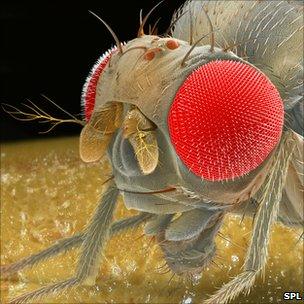Human eye protein senses Earth's magnetism
- Published

The cryptochrome protein comes in more than one type - and the human one can perform as the fly's
A light-sensitive protein in the human eye has been shown to act as a "compass" in a magnetic field, when it is present in flies' eyes.
The study in Nature Communications, external showed that without their natural "magnetoreception" protein, the flies did not respond to a magnetic field - but replacing the protein with the human version restored the ability.
Despite much controversy, no conclusive evidence exists that humans can sense the Earth's magnetic field, and the find may revive interest in the idea.
Although humans, like migratory birds, are known to have cryptochrome in their eyes, the idea of human magnetoreception has remained largely unexplored since pioneering experiments by Robin Baker of the University of Manchester in the 1980s.
Dr Baker used a long series of experiments on thousands of volunteers that suggested humans could indirectly sense magnetic fields, though he never definitively identified the mechanism. In subsequent years, several groups attempted to repeat those experiments, claiming opposing results.
Time, flies
At the heart of the current study is a molecule called cryptochrome - an ancient protein present, in one of its two major forms, in every animal on Earth.
The protein is implicated in the regulation of circadian rhythms - the "body clocks" of humans and other animals - and in the navigational skills of several species including migratory birds, monarch butterflies, and the fruit fly Drosophila melanogaster.
The exact mechanism behind animals' navigational abilities remains a mystery, however, and an active area of research.
Steven Reppert of the University of Massachusetts Medical School and his colleagues have been following the roles that cryptochrome plays in some of these species for a number of years.
D. melanogaster flies can be genetically engineered to produce cryptochrome-2, the version of the protein present in monarch butterflies and in vertebrate animals including humans.
Last year, Dr Reppert's team showed in a Nature paper, external that flies without either cryptochrome were unable to align themselves with magnetic fields, but that the magnetoreception ability was recovered when the flies produced the non-native cryptochrome-2.
"We developed a system to study the real mechanism of magnetosensing in fruit flies... we can put these proteins from other animals into the fly and ask, 'do these proteins in their different forms actually function as magnetoreceptors?'," Dr Reppert told BBC News.
"Of all the vertebrates, the one that seemed to make the most sense was trying to put in the cryptochrome from humans."
The results mirrored the experiments with monarch butterflies. D. melanogaster flies with no cryptochrome showed no evidence of magnetoreception, but when genetically engineered to produce the human version, they recovered their abilities.
Dr Reppert said that the difficulty in unpicking the nature of human magnetosensing - if it exists - was that, like the circadian rhythms that cryptochromes are also implicated in, we react to it without knowing that we are.
"I would be very surprised if we don't have this sense; it's used in a variety of other animals. I think that the issue is to figure out how we use it."
Dr Baker, who maintains his results proving human magnetoreception were "overwhelming", hopes that the find re-invigorates the pursuit of a final word on the matter.
"I think one of the things that put people off accepting the reality of human magnetoreception 20 years ago was the lack of an obvious receptor," he told BBC News.
"So these new results might actually be enough to tip the balance of credibility. I shall be fascinated to see."